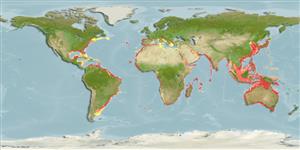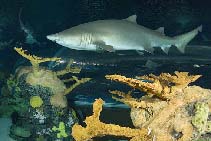Carcharias taurus Rafinesque, 1810
Sand tiger shark
把你的觀察加入 Fish Watcher
| Native range | All suitable habitat | Point map | Year 2050 |

|
| This map was computer-generated and has not yet been reviewed. |
| Carcharias taurus AquaMaps Data sources: GBIF OBIS |
上傳你的 相片 和 影像
Pictures | Videos | Stamps, coins, misc. | Google 影像Carcharias taurus
Picture by Choromanski, J.M.
Pictures | Videos | Stamps, coins, misc. | Google 影像Carcharias taurus
Picture by Choromanski, J.M.
Argentina country information
Common names:
[No common name]
Occurrence: native
Salinity: marine
Abundance: | Ref:
Importance: | Ref:
Aquaculture: | Ref:
Regulations: | Ref:
Uses: no uses
Comments: Also Ref. 26938, 43278, 58839.
National Checklist: Argentina
Country Information: https://www.cia.gov/library/publications/resources/the-world-factbook/geos/ar.html
National Fisheries Authority:
Occurrences: Occurrences Point map
Main Ref: Compagno, L.J.V., 1984
National Database:
Occurrence: native
Salinity: marine
Abundance: | Ref:
Importance: | Ref:
Aquaculture: | Ref:
Regulations: | Ref:
Uses: no uses
Comments: Also Ref. 26938, 43278, 58839.
National Checklist: Argentina
Country Information: https://www.cia.gov/library/publications/resources/the-world-factbook/geos/ar.html
National Fisheries Authority:
Occurrences: Occurrences Point map
Main Ref: Compagno, L.J.V., 1984
National Database:
Common names from other countries
分類 / Names 俗名 | 同種異名 | Catalog of Fishes(屬, 種) | ITIS | CoL | WoRMS | Cloffa
Elasmobranchii 板鰓亞綱 (鯊魚與魟魚) (sharks and rays) > Lamniformes (Mackerel sharks) > Carchariidae (Ragged-tooth sharks)
Etymology: Carcharias: From the Ancient Greek karkharías, shark, derived from kárkharos, sharp or jagged, referring to a shark’s teeth (See ETYFish); taurus: Latin for bull, from Pesce Tauro, local name for this shark in Sicily, Italy, type locality (See ETYFish).
More on author: Rafinesque.
Etymology: Carcharias: From the Ancient Greek karkharías, shark, derived from kárkharos, sharp or jagged, referring to a shark’s teeth (See ETYFish); taurus: Latin for bull, from Pesce Tauro, local name for this shark in Sicily, Italy, type locality (See ETYFish).
More on author: Rafinesque.
Environment: milieu / climate zone / depth range / distribution range 生態學
海洋 礁區魚類; 海洋洄游的 (Ref. 51243); 深度上下限 1 - 191 m (Ref. 247), usually 15 - 25 m (Ref. 43278). 亞熱帶的; 45°N - 48°S, 100°W - 155°E
分布 國家 | FAO區域 | 生態系 | 發現紀錄 | Point map | 簡介 | Faunafri
Circumtropical: Except perhaps the eastern Pacific (Ref. 13568). Indo-West Pacific: Red Sea and off the coasts of South Africa to Japan, Korea and Australia (Ref. 13568). Present in Arafura Sea (Ref. 9819). Western Atlantic: Gulf of Maine to Argentina. Old record from Bermuda, south Brazil (Ref. 26938). Eastern Atlantic: Mediterranean to Cameroon. Northwest Atlantic: Canada (Ref. 5951).
除了也許東太平洋以外發現於所有的溫暖海洋了。 (參考文獻 13568) 印度-西太平洋: 紅海與南非外海至日本,韓國與澳洲.(參考文獻 13568) 在阿拉弗拉海呈現。 (參考文獻 9819) 西大西洋: 緬因灣到阿根廷。 來自百慕達群島,巴西南方的舊的記錄.(參考文獻 26938) 東大西洋: 地中海到喀麥隆。 西北大西洋: 加拿大.(參考文獻 5951)
除了也許東太平洋以外發現於所有的溫暖海洋了。 (參考文獻 13568) 印度-西太平洋: 紅海與南非外海至日本,韓國與澳洲.(參考文獻 13568) 在阿拉弗拉海呈現。 (參考文獻 9819) 西大西洋: 緬因灣到阿根廷。 來自百慕達群島,巴西南方的舊的記錄.(參考文獻 26938) 東大西洋: 地中海到喀麥隆。 西北大西洋: 加拿大.(參考文獻 5951)
Length at first maturity / 大小 / 重量 / 年齡
Maturity: Lm 225.0, range 220 - 230 cm
Max length : 330 cm TL 雄魚/尚未辨別雌雄; (Ref. 27549); common length : 250 cm TL 雄魚/尚未辨別雌雄; (Ref. 6077); 最大體重: 158.8 kg (Ref. 40637)
Max length : 330 cm TL 雄魚/尚未辨別雌雄; (Ref. 27549); common length : 250 cm TL 雄魚/尚未辨別雌雄; (Ref. 6077); 最大體重: 158.8 kg (Ref. 40637)
簡短描述 檢索表 | 型態特徵 | 形態測量圖
背棘 (總數) : 0; 臀棘: 0. A shark with a short, pointed snout, small eyes, protruding spike-like teeth and small, equal-sized dorsal and anal fins; 1st dorsal fin closer to pelvic than to pectoral fins (Ref. 5578). Caudal fin with a pronounced subterminal notch and a short ventral lobe (Ref. 13575). Pale brown or grey, paler below, with dark spots that appear faded in adults; fins plain (Ref. 6586).
一鯊魚有一個短的﹐尖的吻﹐和小的眼, 伸出像長釘一樣的齒與小又大小相同的背鰭與臀鰭; 第一背鰭更靠近腹鰭超過對胸鰭.(參考文獻 5578) 尾鰭有一個明顯的接近端位的凹槽與一個短的腹葉。 (參考文獻 13575) 白褐色或灰色的﹐腹面灰白的, 與出現暗淡的當成魚時的深色斑點; 鰭平原.(參考文獻 6586)
一鯊魚有一個短的﹐尖的吻﹐和小的眼, 伸出像長釘一樣的齒與小又大小相同的背鰭與臀鰭; 第一背鰭更靠近腹鰭超過對胸鰭.(參考文獻 5578) 尾鰭有一個明顯的接近端位的凹槽與一個短的腹葉。 (參考文獻 13575) 白褐色或灰色的﹐腹面灰白的, 與出現暗淡的當成魚時的深色斑點; 鰭平原.(參考文獻 6586)
A common littoral shark found inshore from the surf zone and in shallow bays to at least 191 m on the outer continental shelves (Ref. 13568). Often on or near the bottom but also occurs in midwater or at the surface (Ref. 247). Only shark known to gulp and store air in its stomach to maintain neutral buoyancy while swimming (Ref. 13568). Found singly or in small to large schools (Ref. 247). Feeds on bony fishes, small sharks, rays, squids, crabs, and lobsters (Ref. 5578). Ovoviviparous, embryos feeding on yolk sac and other ova produced by the mother as well as other siblings in the womb (uterine cannibalism) (Ref. 50449). Usually gives birth to 2 pups after a 9-12 months gestation period (Ref.58048). A migratory species in parts of its range, particularly in its northern and southern extremities where pronounced poleward migration occur in the summer and equatorial movements in autumn and winter (Ref. 247). Usually inoffensive and not aggressive when not provoked (Ref. 247) but has known to bite swimmers and be aggressive towards divers with speared fish (Ref. 6586). Utilized for fresh, frozen, smoked and dried for human consumption (Ref. 247); also for fishmeal, liver oil, fins, and hides for leather (Ref. 13568). Flesh highly appreciated in Japan (Ref. 36731).
一種常見的沿海地區鯊魚發現近海從海浪區與在淺灣中在大陸棚外緣上的到至少 191 公尺.(參考文獻 13568) 時常在底部上面或附近也出現於中層水域中或在水表面.(參考文獻 247) 知道的唯一的鯊魚吸取儲存空氣在它的胃裡維持中性浮力然而游泳.(參考文獻 13568) 各別地或在小型到大型的魚群中發現。 (參考文獻 247) 吃硬骨魚類,小的鯊魚,魟,烏賊,螃蟹與龍蝦。 (參考文獻 5578) 卵胎生的, 胚胎吃產生於母親的卵黃囊與其他的卵以及在子宮 (子宮同類相食) 中的其他同源魚種.(參考文獻 50449) 在它的分佈範圍的部份中的一個迴游的種, 特別地在它的最南最北中在哪裡稱為 poleward 迴游出現於夏天與在秋天與冬天出現近赤道的迴游運動.(參考文獻 247) 通常無攻擊性而不是侵略性當沒有被激怒時 (參考文獻 247) 但是已經知道咬游泳者與是用獵殺的魚對潛水者具有侵略性.(參考文獻 6586) 用來做生鮮地了, 冷凍, 煙燻了而且乾燥以供人類的消費;(參考文獻 247) 也用於魚粉,肝油,鰭與皮用做皮革.(參考文獻 13568) 肉高度地在日本欣賞了。 (參考文獻 36731)
一種常見的沿海地區鯊魚發現近海從海浪區與在淺灣中在大陸棚外緣上的到至少 191 公尺.(參考文獻 13568) 時常在底部上面或附近也出現於中層水域中或在水表面.(參考文獻 247) 知道的唯一的鯊魚吸取儲存空氣在它的胃裡維持中性浮力然而游泳.(參考文獻 13568) 各別地或在小型到大型的魚群中發現。 (參考文獻 247) 吃硬骨魚類,小的鯊魚,魟,烏賊,螃蟹與龍蝦。 (參考文獻 5578) 卵胎生的, 胚胎吃產生於母親的卵黃囊與其他的卵以及在子宮 (子宮同類相食) 中的其他同源魚種.(參考文獻 50449) 在它的分佈範圍的部份中的一個迴游的種, 特別地在它的最南最北中在哪裡稱為 poleward 迴游出現於夏天與在秋天與冬天出現近赤道的迴游運動.(參考文獻 247) 通常無攻擊性而不是侵略性當沒有被激怒時 (參考文獻 247) 但是已經知道咬游泳者與是用獵殺的魚對潛水者具有侵略性.(參考文獻 6586) 用來做生鮮地了, 冷凍, 煙燻了而且乾燥以供人類的消費;(參考文獻 247) 也用於魚粉,肝油,鰭與皮用做皮革.(參考文獻 13568) 肉高度地在日本欣賞了。 (參考文獻 36731)
Life cycle and mating behavior 成熟度 | 繁殖 | 產卵場 | 卵 | 孕卵數 | 仔魚
Exhibit ovoviparity (aplacental viviparity), with embryos feeding on other ova produced by the mother (oophagy) after the yolk sac is absorbed, then cannibalize siblings (adelphophagy) (Ref. 50449). Distinct pairing with embrace (Ref. 205). Eggs leave the ovaries, and while in transit in the oviducts are fertilized and enclosed in groups of 16 to 23 in egg cases. However, at some time between fertilization and birth only two (Ref. 5578, 6586) embryos of its group prevails, possibly by devouring its rivals, and proceeds to eat fertilized eggs and smaller potential siblings in utero until birth. According to Springer (1948) (Ref. 39565), it is evident that this species sends forth into the world not only large, well-developed, and even experienced young but may send them forth with a full stomach. The yolk sac is resorbed at a small size, less than 17 cm, and the umbilical scar may be lost. Gestation period may be from 8 to 9 months long. Size at birth 100 cm (Ref. 6586).
Pratt (2001) (Ref. 49562) relates Gordon's (1993) (Ref. 51113) detailed account of the mating behavior of the sand tiger sharks as follows: "mating activities began when the two male C. taurus, having become reluctant to feed, increased their swimming speed, accompanied by clasper flexion and eventual interest in their female tank mates...aggressive displays such as snapping and stalking became frequent, mostly toward species of smaller Carcharhinus in the tank. The males did not become interested in the female until she slowed, moved to the sand area and started cupping her pelvic fins. The two males then became competitive toward each other, circling and tailing, until the alpha male forced the beta male out of the sand area. The female bit the male prior to copulation. She exhibited shielding behavior for several days and then resumed cupping and flaring. The female gradually changed her swimming position and began displaying the submissive behavior. The alpha male swam in increasingly larger circles and began splaying its claspers, then approached the female and exhibited tailing and nosing. Copulation occurred as the male bit into the right flank and trailing edge of the pectoral fin of the female. The male swam side by side with the female, copulating with the right clasper for one to two minutes. After copulation, the male showed little interest in the female." In captivity, males show aggression toward other species after copulation (Ref. 51113, 49562). Females avoid patrolling males by 'shielding' with pelvics close to the substrate (Ref. 51113, 49562). However, female acceptance of future male partner is indicated by a show of 'submissive' body, 'cupping' and 'flaring' of pelvic fins (Ref. 51113, 49562).除了也許東太平洋以外發現於所有的溫暖海洋了。 (參考文獻 13568) 印度-西太平洋: 紅海與南非外海至日本,韓國與澳洲.(參考文獻 13568) 在阿拉弗拉海呈現。 (參考文獻 9819) 西大西洋: 緬因灣到阿根廷。 來自百慕達群島,巴西南方的舊的記錄.(參考文獻 26938) 東大西洋: 地中海到喀麥隆。 西北大西洋: 加拿大.(參考文獻 5951)
主要參考資料
Upload your references | 參考文獻 | 合作者 : Compagno, Leonard J.V. | 合作者
Last, P.R. and J.D. Stevens, 1994. Sharks and rays of Australia. CSIRO, Australia. 513 p. (Ref. 6871)
人類使用
漁業: 商業性; 游釣魚種: 是的
FAO(漁業: 產生, 魚種描繪; publication : search) | FishSource | 周邊海洋
更多資訊
Population dynamics
成長參數
Max. ages / sizes
Length-weight rel.
Length-length rel.
長度-頻率
Mass conversion
入添量
豐度
成長參數
Max. ages / sizes
Length-weight rel.
Length-length rel.
長度-頻率
Mass conversion
入添量
豐度
Physiology
Body composition
Nutrients
耗氧量
游泳類型
游泳速度
Visual pigments
Fish sound
Diseases & Parasites
Toxicity (LC50s)
Body composition
Nutrients
耗氧量
游泳類型
游泳速度
Visual pigments
Fish sound
Diseases & Parasites
Toxicity (LC50s)
Genetics
遺傳學
Heterozygosity
遺傳率
遺傳學
Heterozygosity
遺傳率
工具
Bio-Quiz | E-book | 野外調查 | 檢索表 | 長度- 頻率 Wizard | 生活- 歷史的工具 | 分布圖 | Classification Tree
| Catch-MSY |
特別的報告
下載 XML
網路資源
Aquatic Commons | BHL | Cloffa | Websites from users | 檢查 FishWatcher | CISTI | Catalog of Fishes(屬, 種) | DiscoverLife | DORIS | ECOTOX | Faunafri | Fishtrace | GenBank(基因組, 核甘) | GloBI | GOBASE | GoMexSI (interaction data) | | Google Books | Google Scholar | Google | IGFA World Record | MitoFish | 國家資料庫 | Otolith Atlas of Taiwan Fishes | 公眾的水族館 | PubMed | Reef Life Survey | Scirus | SeaLifeBase | 樹狀分類階層 | Wikipedia(去, 搜尋) | World Records Freshwater Fishing | Zoobank | 動物學的記錄
Estimates based on models
Preferred temperature (Ref. 115969): 12.5 - 28, mean 24.6 (based on 648 cells).
Phylogenetic diversity index (Ref. 82804): PD50 = 0.8125 [Uniqueness, from 0.5 = low to 2.0 = high].
Bayesian length-weight: a=0.00724 (0.00267 - 0.01964), b=2.99 (2.77 - 3.21), in cm Total Length, based on LWR estimates for this (Sub)family-body shape (Ref. 93245).
營養階層 (Ref. 69278): 4.5 ±0.4 se; based on diet studies.
回復力 (Ref. 120179): 非常低的, 最小族群倍增時間超過14 年 (Fec=2; K=0.14-0.17; tmax=17).
Fishing Vulnerability (Ref. 59153): High vulnerability (58 of 100).
Climate Vulnerability (Ref. 125649): Moderate vulnerability (38 of 100).




